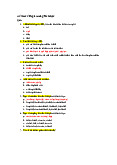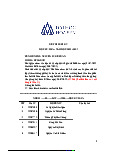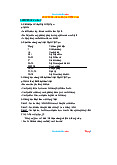







Preview text:
The Three-Hour Brand Sprint
This 3-hour workshop helps to make the abstract idea of the exercises, the team gets a common language to describe what their company is about*4*and all subsequent
squishy decisions about visuals, voice, and identity become way easier.
Source: Google Ventures Library (includes further detailed explanation):
https://library.gv.com/the-three-hour-brand-sprint-3ccabf4b768a TIME TITLE DESCRIPTION ADDITIONAL INFO 09:00 Preparations
Get the right team: You need two to six participants Homework (optional) 0'
for a Bran Sprint. These have to be company
For an optimal Brand Sprint, ask everyone executives
to do two things before you start: Must have in the room: CEO
And at least one of these: Co-founder / Head of Read this post detailing the
marketing / Head of product or design
complete process with examples.
Sometimes, you might bring in a customer expert. Fill out this PDF.
One participant must be the (But if you don9t have time before the
Be sure to book your time in a room with lots of
sprint, don9t worry*4*it9ll still work.)
whiteboard space, and bring blank white copy paper and some pens. 09:00 Introduction
Introduce yourself and the goal of the session
Goal of the session: Make the abstract 5' idea of Set the ground rules
concrete. After doing the exercises, the
team gets a common language to
describe what their company is about*4*
and all subsequent squishy decisions
about visuals, voice, and identity become way easier. 09:05 20 Year Roadmap
Most teams focus on what they9re doing now, which Steps: 15'
makes sense. But if your company is successful, your
1. Draw a timeline on the whiteboard,
brand will last a long time. So for the first exercise, you9ll
labeled with 5, 10, 15, and 20 years
look into the future and think about what your company into the future (see attached)
might be doing 20 years from now.
2. Each person quietly writes down his
or her own prediction for all four dates.
3. Going around the room, each person
reads their answers aloud and the
facilitator writes them on the whiteboard. No argument or discussion yet.
4. Each person looks at the list and
quietly writes down their favorite answers.
5. Going around the room, each person
reads their votes aloud and the
facilitator marks the votes on the whiteboard.
6. Discuss and argue for about five
minutes (use a timer to keep it to five minutes!).
7. The Decider chooses her favorite item for each future date.
8. Take a photo of the whiteboard and
put it into a new slide deck called TIME TITLE DESCRIPTION ADDITIONAL INFO 09:20 What, How, Why
What, How, Why is an exercise based completely on Steps: 30'
Simon Sinek9s 1. Start by drawing three concentric
You are going to collect answers to these questions:
circles on a whiteboard. Label the
outside circle What does your company do?
A phrase or sentence describing your primary example attached)
business for the next five years. Examples: 2. Each person quietly writes down his
toothpaste=, or her ideas for what, how, and why. How do you do it?
3. Going around the room, each person
What9s your secret sauce? What technology or
reads their answers aloud and the
approach sets you apart from the competition?
facilitator writes them on the
Examples: whiteboard. No argument or discussion yet.
4. Each person looks at the list and Why?
quietly writes down their favorite
You can think of the why as the reason you get answers.
out of bed in the morning and go to work. The
5. Going around the room, each person
why should reflect the core reason your company
reads their votes aloud and the
exists, and it won9t change much over time. You
facilitator marks the votes on the
may pivot the business, launch new products, and whiteboard.
enter new markets, but your why remains the
6. Discuss the WHAT and HOW for
same. Examples: about five minutes each, but don9t
people get where they need to go=, etc.
argue the semantics 4 it9s not that important.
7. At the end of each five-minute
segment, the Decider chooses her favorite answer.
8. Discuss the WHY for about ten
minutes. This can be difficult, so agree
that today9s version will be a
placeholder 4 you can come back to it later.
9. After ten minutes, the Decider makes the call.
10. Take a photo of the whiteboard and add it to your slide deck. 09:50 Top Three Values
Make your WHY more specific by listing and ranking Steps: 30'
your company values. Lots of companies list their
1. Each person quietly writes down a
values, but very few do the hard work to reduce and
list of values4as many as they can
prioritize. And prioritization is essential*4*you9ve got to think of.
cut down to just three values and rank them so you
2. Going around the room, each person
have one single most important value.
reads their values aloud and the
If you have ten or twenty values, anything you do can be
facilitator writes them on the
considered whiteboard in one giant list. No
value makes decisions easier, clarifies your message, argument or discussion yet.
and sets you apart from the competition. It9s hard work 3. Each person looks at the list and but worth it.
quietly writes down the three values
they think best describe the company.
4. Going around the room, each person
reads their votes aloud and the
facilitator marks the votes on the whiteboard.
5. Discuss for about five minutes.
6. At the end of five minutes, the
Decider makes the call. Give her a
few minutes to quietly write down her
top three values, in order. This is the
hard part, but it9s also the key to
success4you must narrow down to
three, and most importantly, you must
choose a single most important value.
7. The Facilitator writes the final decision on the whiteboard.
8. Take a photo of the whiteboard and add it to the slide deck. 10:20 Break 15' TIME TITLE DESCRIPTION ADDITIONAL INFO 10:35 Top Three Audiences
Values are helpful for brand decisions, but they9re not Steps: 30'
the whole picture*4*you need to know who you9re
1. Each person quietly writes down their
talking to. In this exercise, you9ll list all your possible own list of the company9s
audiences, then figure out who9s most important. audiences.
2. Going around the room, each person
reads their list aloud and the
facilitator writes one giant list on the whiteboard. No argument or discussion yet.
3. Each person looks at the list and quietly writes down the two
audiences they believe are most important.
4. Going around the room, each person
reads their votes aloud and the
facilitator marks the votes on the whiteboard.
5. Discuss for about five minutes.
6. At the end of five minutes, the
Decider makes the call. Give her a
few minutes to quietly write down her top three audiences, in order.
7. The Facilitator writes the final decision on the whiteboard.
8. Take a photo of the whiteboard and add it to the slide deck. 11:05 Personality Sliders
In this exercise, you9ll position your company9s 30'
between pairs of brand extremes:
1. Draw a diagram on the whiteboard with the four ranges
2. Give everyone a printout of this diagram (PDF here)
3. Each person marks their printout to indicate where they think the company sits on each range.
4. Everyone takes turns marking the
whiteboard with their sliders, then
labeling each one with their initials.
5. Discuss any diagram where people
disagree about where the company
should be. For example, if Andy put a
dot right by Beatrice put a dot right by should explain their positions. Time
this discussion4it needn9t take longer than five to ten minutes.
6. At the end of the discussion, the
Decider makes the call. She should
be given a few minutes to quietly plot
her final choices on the whiteboard.
7. Take a photo of the whiteboard and add it to the slide deck. TIME TITLE DESCRIPTION ADDITIONAL INFO 11:35 Competitive Landscape
This last exercise is a simple 2x2 matrix with the 1. Draw a 2x2 matrix 30' following axes: 1. 2. Classic to Modern axis Expressive to Reserved
2. Each person writes down a list of
other companies in the same space or industry.
3. Each person chooses the one or two
most important companies on their list.
4. Going around the room, each person
reads their choices aloud and the
facilitator writes the company names
on sticky notes (one name per sticky).
5. One at a time, place the sticky notes
on the matrix. Quickly discuss where it should go. Repeat.
6. Once all the sticky notes are up, the
facilitator should ask the Decider if
she9d like to move any of the notes.
7. Finally, plot your own company on
the matrix. This should be fairly easy
4 after all, you9ve just been doing
brand exercises for 150 minutes.
8. Double-check: Look back at the rest
of the sprint exercises. Does this
placement make sense for your 20- Year Roadmap, What How Why,
Values, Audience, and Brand Sliders?
9. As always, the Decider makes the final call.
10. Take a photo of this whiteboard and add it to the slide deck. 12:05 Closing Wrap up the session.
Now you have a complete Super Simple 5'
Brand Guide! That9s right*4*it9s just a slide
deck filled with whiteboard photos. But don9t underestimate it.
Taken together, these six diagrams are a
powerful, concrete representation of your
company9s brand. When you9re faced with
a big decision*4*about naming, identity,
marketing, or even company policy*4*you
can use these diagrams as a guide 12:10 TOTAL LENGTH: 03:10
The Three-Hour Brand Sprint - block details 09:00 Preparations 0'
Get the right team: You need two to six participants for a Bran Sprint. These have to be company executives Must have in the room: CEO
And at least one of these: Co-founder / Head of marketing / Head of product or design
Sometimes, you might bring in a customer expert.
One participant must be the Be sure to book your time in a room with lots of whiteboard space, and bring blank white copy paper and some pens. ADDITIONAL INFORMATION Homework (optional)
For an optimal Brand Sprint, ask everyone to do two things before you start:
Read this post detailing the complete process with examples. Fill out this PDF.
(But if you don9t have time before the sprint, don9t worry*4*it9ll still work.) INSTRUCTIONS
The Decider: One participant must be the your brand. In most cases, the Decider is the CEO, but in some cases the Decider could be a co-
founder or CMO. This does not work without the Decider. Find some way to fit the Brand Sprint into
her schedule. If she won9t make the time, don9t do the sprint. 09:00 Introduction 5'
Introduce yourself and the goal of the session Set the ground rules ADDITIONAL INFORMATION
Goal of the session: Make the abstract idea of exercises, the team gets a common language to describe what their company is about*4*and all
subsequent squishy decisions about visuals, voice, and identity become way easier. INSTRUCTIONS Ground rules for the session:
No devices. Put away your laptops, phones, Oculus Rifts, etc. (But do take a break in the middle for snacks and email.)
Time-box all activities with a Time Timer or other simple timer. 09:05 20 Year Roadmap 15'
Most teams focus on what they9re doing now, which makes sense. But if your company is successful,
your brand will last a long time. So for the first exercise, you9ll look into the future and think about
what your company might be doing 20 years from now. ADDITIONAL INFORMATION Steps:
1. Draw a timeline on the whiteboard, labeled with 5, 10, 15, and 20 years into the future (see attached)
2. Each person quietly writes down his or her own prediction for all four dates.
3. Going around the room, each person reads their answers aloud and the facilitator writes them
on the whiteboard. No argument or discussion yet.
4. Each person looks at the list and quietly writes down their favorite answers.
5. Going around the room, each person reads their votes aloud and the facilitator marks the votes on the whiteboard.
6. Discuss and argue for about five minutes (use a timer to keep it to five minutes!).
7. The Decider chooses her favorite item for each future date.
8. Take a photo of the whiteboard and put it into a new slide deck called Guide=. INSTRUCTIONS
Note: Nobody will expect you to stick to the 20-Year Roadmap4that9s not the point. The point of the
20-Year Roadmap is to get your team thinking about the lifetime of your brand. A great brand will
last until the year 2040 4 and beyond. 09:20 What, How, Why 30'
What, How, Why is an exercise based completely on Simon Sinek9s You are going to collect answers to these questions: What does your company do?
A phrase or sentence describing your primary business for the next five years. Examples: toothpaste=, How do you do it?
What9s your secret sauce? What technology or approach sets you apart from the competition? Examples: Why?
You can think of the why as the reason you get out of bed in the morning and go to work. The
why should reflect the core reason your company exists, and it won9t change much over time.
You may pivot the business, launch new products, and enter new markets, but your why
remains the same. Examples: etc. ADDITIONAL INFORMATION Steps:
1. Start by drawing three concentric circles on a whiteboard. Label the outside circle middle circle 2. Each person quietly writes down his or her ideas for what, how, and why.
3. Going around the room, each person reads their answers aloud and the facilitator writes them
on the whiteboard. No argument or discussion yet.
4. Each person looks at the list and quietly writes down their favorite answers.
5. Going around the room, each person reads their votes aloud and the facilitator marks the votes on the whiteboard.
6. Discuss the WHAT and HOW for about five minutes each, but don9t argue the semantics 4 it9s not that important.
7. At the end of each five-minute segment, the Decider chooses her favorite answer.
8. Discuss the WHY for about ten minutes. This can be difficult, so agree that today9s version will be
a placeholder 4 you can come back to it later.
9. After ten minutes, the Decider makes the call.
10. Take a photo of the whiteboard and add it to your slide deck. INSTRUCTIONS
Simon Sinek's Golden Circle TED talk: How great leaders inspire action
Sinek9s premise is basically this: You need to know why you9re in business 4 and talk about it. When
a company has a strong motivation and that motivation shines through, customers buy the product.
It9s easy to find supporting examples. Sinek points to Apple, but companies like Nike, Patagonia,
Airbnb, and LEGO obviously fit the bill. 09:50 Top Three Values 30'
Make your WHY more specific by listing and ranking your company values. Lots of companies list
their values, but very few do the hard work to reduce and prioritize. And prioritization is essential*4*
you9ve got to cut down to just three values and rank them so you have one single most important value.
If you have ten or twenty values, anything you do can be considered important value makes decisions easier, clarifies your message, and sets you apart from the
competition. It9s hard work but worth it. ADDITIONAL INFORMATION Steps:
1. Each person quietly writes down a list of values4as many as they can think of.
2. Going around the room, each person reads their values aloud and the facilitator writes them on
the whiteboard in one giant list. No argument or discussion yet.
3. Each person looks at the list and quietly writes down the three values they think best describe the company.
4. Going around the room, each person reads their votes aloud and the facilitator marks the votes on the whiteboard.
5. Discuss for about five minutes.
6. At the end of five minutes, the Decider makes the call. Give her a few minutes to quietly write
down her top three values, in order. This is the hard part, but it9s also the key to success4you
must narrow down to three, and most importantly, you must choose a single most important value.
7. The Facilitator writes the final decision on the whiteboard.
8. Take a photo of the whiteboard and add it to the slide deck. 10:20 Break 15' 10:35 Top Three Audiences 30'
Values are helpful for brand decisions, but they9re not the whole picture*4*you need to know who
you9re talking to. In this exercise, you9ll list all your possible audiences, then figure out who9s most important. ADDITIONAL INFORMATION Steps:
1. Each person quietly writes down their own list of the company9s audiences.
2. Going around the room, each person reads their list aloud and the facilitator writes one giant
list on the whiteboard. No argument or discussion yet.
3. Each person looks at the list and quietly writes down the two audiences they believe are most important.
4. Going around the room, each person reads their votes aloud and the facilitator marks the votes on the whiteboard.
5. Discuss for about five minutes.
6. At the end of five minutes, the Decider makes the call. Give her a few minutes to quietly write
down her top three audiences, in order.
7. The Facilitator writes the final decision on the whiteboard.
8. Take a photo of the whiteboard and add it to the slide deck. INSTRUCTIONS
Who qualifies as an question: Whose opinion do you care about?
When you answer that, you may realize your brand matters not just to customers but also to other
businesses, reporters, advertisers, employees, potential hires, and heck, maybe even government regulators.
A common question is whether to use broad categories (like Really it9s up to you*4*most companies just know whether segments or categories are the best way to go. 11:05 Personality Sliders 30'
In this exercise, you9ll position your company9s ADDITIONAL INFORMATION Steps:
1. Draw a diagram on the whiteboard with the four ranges
2. Give everyone a printout of this diagram (PDF here)
3. Each person marks their printout to indicate where they think the company sits on each range.
4. Everyone takes turns marking the whiteboard with their sliders, then labeling each one with their initials.
5. Discuss any diagram where people disagree about where the company should be. For example,
if Andy put a dot right by their positions. Time this discussion4it needn9t take longer than five to ten minutes.
6. At the end of the discussion, the Decider makes the call. She should be given a few minutes to
quietly plot her final choices on the whiteboard.
7. Take a photo of the whiteboard and add it to the slide deck. 11:35 Competitive Landscape 30'
This last exercise is a simple 2x2 matrix with the following axes: Classic to Modern Expressive to Reserved ADDITIONAL INFORMATION 1. Draw a 2x2 matrix
1. 2. 2. Each person writes down a list of other companies in the same space or industry.
3. Each person chooses the one or two most important companies on their list.
4. Going around the room, each person reads their choices aloud and the facilitator writes the
company names on sticky notes (one name per sticky).
5. One at a time, place the sticky notes on the matrix. Quickly discuss where it should go. Repeat.
6. Once all the sticky notes are up, the facilitator should ask the Decider if she9d like to move any of the notes.
7. Finally, plot your own company on the matrix. This should be fairly easy 4 after all, you9ve just
been doing brand exercises for 150 minutes.
8. Double-check: Look back at the rest of the sprint exercises. Does this placement make sense for
your 20-Year Roadmap, What How Why, Values, Audience, and Brand Sliders?
9. As always, the Decider makes the final call.
10. Take a photo of this whiteboard and add it to the slide deck. 12:05 Closing 5' Wrap up the session. ADDITIONAL INFORMATION
Now you have a complete Super Simple Brand Guide! That9s right*4*it9s just a slide deck filled with
whiteboard photos. But don9t underestimate it.
Taken together, these six diagrams are a powerful, concrete representation of your company9s
brand. When you9re faced with a big decision*4*about naming, identity, marketing, or even company
policy*4*you can use these diagrams as a guide




